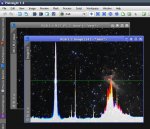// Hardcoded values, for testing purposes
#include <pjsr/UndoFlag.jsh>
#define BLEND true
#define RED_X true
#define GRE_X true
#define BLU_X true
#define OPACITY 0.8
var window = ImageWindow.activeWindow;
var view = window.currentView;
var img = window.currentView.image;
function sumPixelValues( img ) {
var x, v;
var x_r = 0;
var x_g = 0;
var x_b = 0;
var width = img.width;
var height = img.height;
var y_values = Math.round( height / 2 ); // the Y center...
//var y_values = 100; // or any other Y value
var window_graph = new ImageWindow( width, height, 3, 16, false, true );
var view_graph = window_graph.mainView;
var img_graph = window_graph.currentView.image;
view_graph.beginProcess( UndoFlag_NoSwapFile );
// X Values
for (x = 0; x < width; x++) {
x_r = img.sample(x, y_values, 0); // 0 = Red
x_g = img.sample(x, y_values, 1); // 1 = Green
x_b = img.sample(x, y_values, 2); // 2 = Blue
// Red
if( RED_X ) {
x_r = Math.floor(x_r * height) - 1;
for (v = 0; v <= x_r; v++) {
img_graph.setSample(1, x, v, 0);
};
};
// Green
if( GRE_X ) {
x_g = Math.floor(x_g * height) - 1;
for (v = 0; v <= x_g; v++) {
img_graph.setSample(1, x, v, 1);
};
};
// Blue
if( BLU_X ) {
x_b = Math.floor(x_b * height) - 1;
for (v = 0; v <= x_b; v++) {
img_graph.setSample(1, x, v, 2);
}
};
// Y axis of sample values
// First goto black...
img_graph.setSample(0, x, (height - y_values - 1), 0);
img_graph.setSample(0, x, (height - y_values - 1), 1);
img_graph.setSample(0, x, (height - y_values - 1), 2);
// then, green line
img_graph.setSample(1, x, (height - y_values - 1), 1);
}
// Trick to match views
img_graph.rotate180();
img_graph.mirrorHorizontal();
//
if( BLEND ) {
PixelMathActions( view, view_graph );
window_graph.forceClose();
} else {
view_graph.endProcess();
window_graph.bringToFront();
}
}
function PixelMathActions(img_1, img_2) {
var pm = new PixelMath;
with ( pm ) {
expression = img_1.id + "+" + "(" + img_2.id + " * " + OPACITY + ")";
useSingleExpression = true;
symbols = "";
use64BitWorkingImage = false;
rescale = false;
rescaleLower = 0.0000000000;
rescaleUpper = 1.0000000000;
truncate = true;
truncateLower = 0.0000000000;
truncateUpper = 1.0000000000;
createNewImage = true;
newImageWidth = SameAsTarget;
newImageHeight = SameAsTarget;
newImageAlpha = false;
newImageColorSpace = SameAsTarget;
newImageSampleFormat = SameAsTarget;
}
pm.executeOn( img_1, false );
}
sumPixelValues( img );


